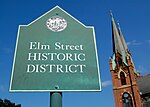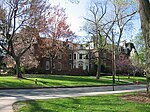Smith College Archives
Smith College is a private, independent women's liberal arts college with coed graduate and certificate programs, located in Northampton, Massachusetts, United States. The Smith College Archives document the life of the College by collecting materials created by students, faculty, administrative and departmental staff during the course of their time here. The records in the College Archives can provide researchers with answers to specific questions or help them to understand broad social and cultural issues. The collections contain materials derived from: administrative records biographical records academic life student life buildings and grounds audiovisual materialsThe collection spans nearly 20,000 linear feet and is one of the contributing collections to "The History of Women’s Education Open Access Portal Project" funded through the National Endowment for the Humanities.
Excerpt from the Wikipedia article Smith College Archives (License: CC BY-SA 3.0, Authors).Smith College Archives
Elm Street, Northampton
Geographical coordinates (GPS) Address Nearby Places Show on map
Geographical coordinates (GPS)
| Latitude | Longitude |
|---|---|
| N 42.3171334 ° | E -72.6385327 ° |
Address
Young Science Library
Elm Street
01063 Northampton
Massachusetts, United States
Open on Google Maps









